

Dada. Dada (/ˈdɑːdɑː/) or Dadaism was an art movement of the European avant-garde in the early 20th century.
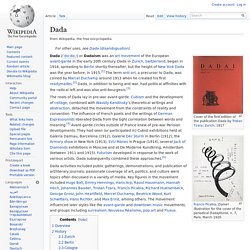
Dada in Zurich, Switzerland, began in 1916, spreading to Berlin shortly thereafter, but the height of New York Dada was the year before, in 1915.[1] The term anti-art, a precursor to Dada, was coined by Marcel Duchamp around 1913 when he created his first readymades.[2] Dada, in addition to being anti-war, had political affinities with the radical left and was also anti-bourgeois.[3] Francis Picabia, Dame! Illustration for the cover of the periodical Dadaphone, n. 7, Paris, March 1920 Overview[edit] Francis Picabia, (left) Le saint des saints c'est de moi qu'il s'agit dans ce portrait, 1 July 1915; (center) Portrait d'une jeune fille americaine dans l'état de nudité, 5 July 1915: (right) J'ai vu et c'est de toi qu'il s'agit, De Zayas! Dada was an informal international movement, with participants in Europe and North America. Neoclassicism.
Cubism. A primary influence that led to Cubism was the representation of three-dimensional form in the late works of Paul Cézanne, which were displayed in a retrospective at the 1907 Salon d'Automne.[3] In Cubist artwork, objects are analyzed, broken up and reassembled in an abstracted form—instead of depicting objects from one viewpoint, the artist depicts the subject from a multitude of viewpoints to represent the subject in a greater context.[4] Conception and origins[edit] Pablo Picasso, 1909-10, Figure dans un Fauteuil (Seated Nude, Femme nue assise), oil on canvas, 92.1 x 73 cm, Tate Modern, London Cubism began between 1907 and 1911.
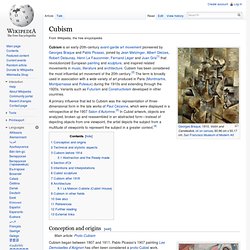
Pablo Picasso's 1907 painting Les Demoiselles d'Avignon has often been considered a proto-Cubist work. Georges Braque's 1908 Houses at L’Estaque (and related works) prompted the critic Louis Vauxcelles to refer to bizarreries cubiques (cubic oddities). John Berger identifies the essence of Cubism with the mechanical diagram. "M. Cubism before 1914[edit] Romanticism. Artistic, literary, musical, and intellectual movement The movement emphasized intense emotion as an authentic source of aesthetic experience, placing new emphasis on such emotions as fear, horror and terror, and awe — especially that experienced in confronting the new aesthetic categories of the sublime and beauty of nature.[7][8] It elevated folk art and ancient custom to something noble, but also spontaneity as a desirable characteristic (as in the musical impromptu).
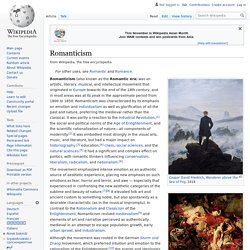
In contrast to the Rationalism and Classicism of the Enlightenment, Romanticism revived medievalism[9] and elements of art and narrative perceived as authentically medieval in an attempt to escape population growth, early urban sprawl, and industrialism. Defining Romanticism[edit] Basic characteristics[edit] Realism (arts) Realism in the arts may be generally defined as the attempt to represent subject matter truthfully, without artificiality and avoiding artistic conventions, implausible, exotic and supernatural elements.
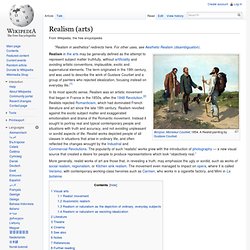
The term originated in the 19th century, and was used to describe the work of Gustave Courbet and a group of painters who rejected idealization, focusing instead on everyday life.[1] In its most specific sense, Realism was an artistic movement that began in France in the 1850s, after the 1848 Revolution.[2] Realists rejected Romanticism, which had dominated French literature and art since the late 18th century. Realism revolted against the exotic subject matter and exaggerated emotionalism and drama of the Romantic movement. Instead it sought to portray real and typical contemporary people and situations with truth and accuracy, and not avoiding unpleasant or sordid aspects of life. The Realist movement began in the mid-19th century as a reaction to Romanticism and History painting. Modernism. Hans Hofmann, "The Gate", 1959–1960, collection: Solomon R.
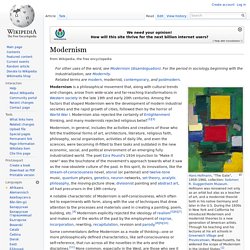
Guggenheim Museum. Hofmann was renowned not only as an artist but also as a teacher of art, and a modernist theorist both in his native Germany and later in the U.S. During the 1930s in New York and California he introduced Modernism and modernist theories to a new generation of American artists. Avant-garde. The avant-garde (from French, "advance guard" or "vanguard", literally "fore-guard"[1]) are people or works that are experimental or innovative, particularly with respect to art, culture, and politics.

The avant-garde also promotes radical social reforms. It was this meaning that was evoked by the Saint Simonian Olinde Rodrigues in his essay "L'artiste, le savant et l'industriel" ("The artist, the scientist and the industrialist", 1825), which contains the first recorded use of "avant-garde" in its now customary sense: there, Rodrigues calls on artists to "serve as [the people's] avant-garde", insisting that "the power of the arts is indeed the most immediate and fastest way" to social, political and economic reform.[3] Theories[edit] Several writers have attempted, with limited success, to map the parameters of avant-garde activity.
Bürger's essay also greatly influenced the work of contemporary American art-historians such as the German Benjamin H. Relation to mainstream society[edit] Plakatstil. Plakatstil ("poster style" in German), also known as sachplakat, was an early poster style of art that began in the 1900s and originated out of Germany.[1] It was started by Berliner Lucian Bernhard in 1906.

The traits of this style of art are usually bold eye-catching fonts with flat colors.[2] Shapes and objects are simplified while there is a central image which is the focus of the poster. Plakatstil shied away from the complexity of Art Nouveau and helped emphasize a more modern outlook on poster art. Famous Plakatstil artists include Ludwig Hohlwein, Edmund Edel, Ernst Deutsch-Dryden, Hans Lindenstadt, Julius Klinger, Julius Gipkens, Paul Scheurich, Karl Schulpig and Hans Rudi Erdt.[3] Das Plakat was a German art magazine that was published in 1910 from the Verein der Plakat Freunde (The Society for Friends of the Poster).[4] The society and magazine were founded by dentist Hans Sachs.
Lucian Bernhard was also director for the society.